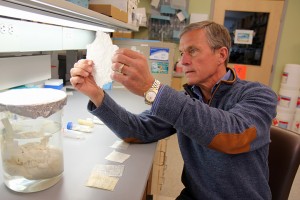

By Lauran Neergaard
Associated Press
WASHINGTON — Scientists implanted thin sheets of scaffolding-like material from pigs into a few young men with disabling leg injuries — and say the experimental treatment coaxed the men’s own stem cells to regrow new muscle.
The research, funded by the Defense Department, included just five patients, a small first step in the complex quest for regenerative medicine.
But the researchers described some of the men improving enough to no longer need canes, or to ride a bicycle again, after years of living with injuries that today have no good treatment.
“The real rush for someone like myself is to see this patient being able to do these things and not struggle and have a smile on his face,” said Dr. Stephen Badylak of the University of Pittsburgh School of Medicine. He led the study, which was reported Wednesday in the journal Science Translational Medicine.
Muscles have some natural ability to regenerate after small injuries. But if too much is lost — from a car accident, a sports injury or, for soldiers, a bomb blast — the body can’t heal properly. Hard scar tissue fills the gap instead. Called volumetric muscle loss, a severe enough injury can leave an arm or leg essentially useless.
The new experiment combines bioengineering with a heavy dose of physical therapy to spur stem cells that are roaming the body to settle on the injury and turn into the right kind of tissue to repair it.
First, surgeons remove the scar tissue.
Then they implant something called an “extracellular matrix” derived from pigs. It’s the connective scaffolding that remains after cells are removed from a tissue. (Without cells, the immune system doesn’t reject it.) Such material has been used for many years as a kind of mesh in treatments for skin ulcers and in hernia repair.
What’s new here: The matrix temporarily fills in the injury, between edges of remaining muscle. As the scaffolding slowly degrades, it releases chemical signals that attract stem cells to the site, Badylak said.
Then physical therapy puts tension on the spot, in turn signaling the stem cells that they need to form strong, stretchy muscle tissue, he said. Without the exercise, Badylak cautioned, those cells won’t get the message to boost muscle mass, and scar tissue could return.
To start proving that’s what happens, Badylak’s team first removed chunks of leg muscle from mice and administered the treatment. In-depth tests showed which cells moved in, and showed that they created working muscle.
Then it was time for human testing, with three military veterans and two civilians. Each had lost between 60 percent and 90 percent of an affected leg muscle — two from the thigh, the rest from the lower leg — anywhere from about a year to seven years earlier.
The men, in their 20s and 30s, underwent a few months of customized physical therapy to get their muscle function to its maximum capacity.
Then they received the implants, followed by more physical therapy that began within 48 hours after surgery.
Six months later, biopsies and medical scans showed some new muscle grew in all the men. Three patients were officially deemed a success because their legs were stronger by 20 percent or more after the surgery. They had dramatic improvements in tests showing they could hop or squat on the injured leg. Badylak said the two other men had some improvement in balance and quality of life, but not enough to meet the study’s definition of success.




